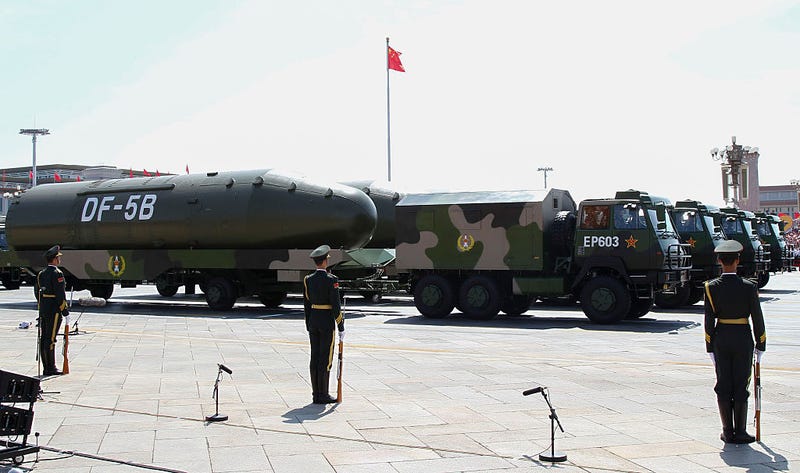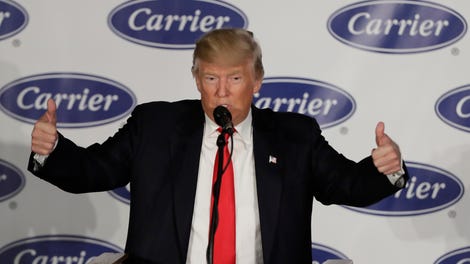
This month China tested a new long-range intercontinental ballistic missile capable of raining 10 nuclear warheads upon its target at once. The test marks what is likely to be a preamble to a highly unnecessary diplomatic clash between two nations who don’t need any more reasons to fight.
Advertisement
The DF-5C missile, which is a newer variant of China’s DF-5 ICBM, was launched earlier in January from the Taiyuan Space Launch Center in central China and landed in an impact range in the desert in western China, according to the Washington Free Beacon. Mounted on the missile were 10 multiple independently targetable reentry vehicles, or MIRVs, each one containing a nuclear warhead capable of leveling an entire city.
The list of countries which have MIRVsincludes the United States, China, Russia, the United Kingdom, and France, and they’re considered to be so dangerous to world peace that the U.S. and Russia once tried to ban them towards the end of the Cold War. That bilateral agreement between the two countries never went into effect.
Advertisement
Little is known about China’s DF-5C missile launch, other than the Pentagon’s awareness that the test took place. But China’s recent missile moves have caused some speculation that Beijing is ready to prove it isn’t afraid to confront President Trump over his hawkish language. Earlier in the campaign, he called for a 45 percent tariff on Chinese exports. After he won, Trump drew China’s ire in December by calling Taiwanese President Tsai Ing-wen, which was considered an affront to the “One China Policy” that has been in place since the 1970s. China responded with its own muscle flexing, starting with the seizure of a Navy drone in the South China Sea in December, which they eventually gave it back.
China has responded more aggressively in other cases, though. It recently deployed its DF-41 ICBM near the Russian border in a move that also was supposedly targeting Trump. And when we say supposedly, consider that it was the Chinese Communist Party’s mouthpiece, Global Times, which said this:
Some media claimed that the Chinese military intentionally revealed the Dongfeng-41 and connected it with the inauguration of US President Donald Trump. They think this is Beijing’s response to Trump’s provocative remarks on China.
Before Trump took power, his team showed a tough stance toward China, and in turn, Beijing will ready itself for pressures imposed by the new US government. It is logical that Beijing attaches particular importance to the Dongfeng-41 as a strategic deterrence tool.
Considered one of the most advanced ICBM’s in the world, the DF-5C missile has a range of 12,000 kilometers and can carry 12 nuclear warheads. Though China’s nuclear stockpile of 260 warheads is not match for America’s estimated 6,800 warheads, the tense relationship between Beijing and Washington will not help in future talks to minimize tensions over the South China Sea, trade, the UN and other pressing issues.
Sponsored
Relations between the U.S. and China were never especially warm during former President Barack Obama’s time in the Oval Office, but there were moments of success. In December 2015, China and the U.S. renewed the 1985 U.S.-China nuclear agreement that was set to expire the end of that year. It allows for transfer of materials, information, technology and equipment (such as reactors) for nuclear research and power reduction. In 2016, Obama and Chinese President Xi Jinping released a joint statement pledging cooperation on nuclear security, especially on the front of preventing terrorists from acquiring nuclear or other radioactive materials.
All of this took place while both nations were at odds over the South China Sea, trade and China’s often obstructionist role on the UN Security Council. That said, Obama was able to walk a very delicate tightrope that ended with him leaving U.S.-China relations on at least cordial terms. Trump has barely been in office for two weeks and China has aggressively postured Washington twice with nuclear weapons deployments and tests.
Because China has geopolitical objectives that diametrically oppose America’s, the relationship will likely never be great. But preventing an armed conflict between Beijing and Washington always seemed like a perfectly realistic goal.
Advertisement
Advertisement
If Trump is wise, he will recognize this and work toward the same.
















